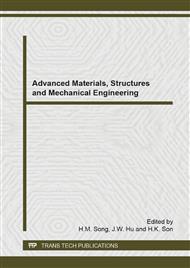p.1119
p.1125
p.1134
p.1141
p.1145
p.1150
p.1160
p.1164
p.1168
Researches on the Chaotic Characteristics of Fluctuating Pressure in Slit-Type Energy Dissipater
Abstract:
On the basis of research on energy dissipation scheme of Changheba hydropower station in model tests, the chaotic characteristics of the fluctuating pressure in the slit-type contraction section were studied with the employment of chaotic theory. According to Takens’ embedding theorem, we performed a phase space reconstruction on the measured fluctuating series, where the optimal delay time was determined with the average mutual information (AMI) method, the optimal embedding dimension was determined with the averaged false nearest neighbor (AFN) method. Calculated from the testing results, the optimal delay time was ranging from 7 to 10 while the optimal embedding dimension was ranging from 12 to 14. With the optimal embedding parameters obtained, the correlation dimension D2 and the largest Lyaponov exponent λ1 was calculated, with the obtained D2 varying from 7.626 to 8.821 and λ1 varying from 0.091 to 0.302. Conclusively, the flow characteristics on the floor were more complex than those on the sidewall, while the flow structure exhibited no essential difference. Moreover, the distribution law of correlation dimension indicated that the effects of contraction on the flow around the floor were more remarkable; however, the calculated largest Lyapunov exponent could only be served as a qualitative indicator of a chaotic system, without any instruction to the degree of chaos.
Info:
Periodical:
Pages:
1150-1159
Citation:
Online since:
September 2014
Authors:
Price:
Сopyright:
© 2014 Trans Tech Publications Ltd. All Rights Reserved
Share:
Citation:


